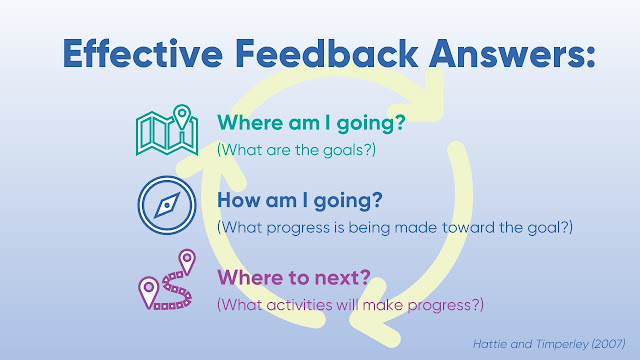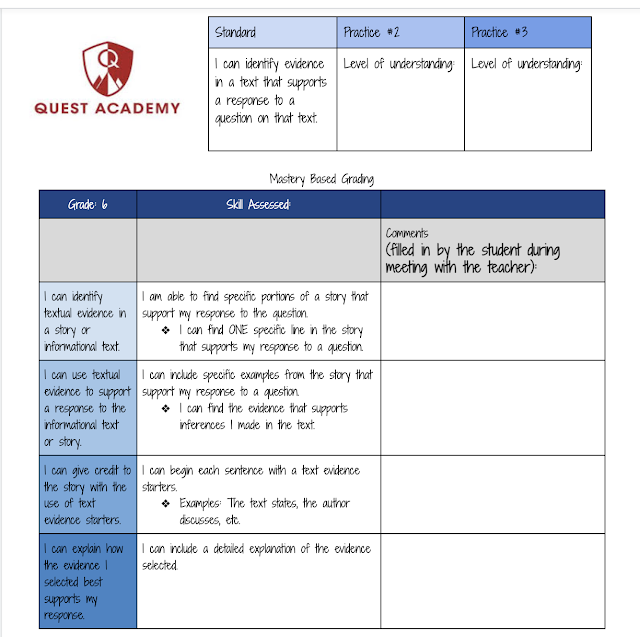In order to learn and grow, some type of feedback is needed along the way. While an experience can be a foundation for learning, it is the feedback that often serves as a catalyst for reflection. At this point, learners gain valuable insight into the strategies being used so that adjustments can be made to make better progress. There is also a robust research base to validate its importance. Goodwin & Miller (2012) provided this summary:
In Marzano, Pickering, and Pollock's 2001 meta-analysis, McREL researchers found an effect size for feedback of 0.76, which translates roughly into a 28-percentile point difference in average achievement (Beesley & Apthorp, 2010; Dean, Pitler, Hubbell, & Stone, 2012). John Hattie (2009) found a similar effect size of 0.73 for feedback in his synthesis of 800 meta-analyses of education research studies. It was found that feedback ranked among the highest of hundreds of education practices he studied.
All feedback isn’t created equal. For it to have an impact, it must be timely, practical, specific, facilitated in a positive manner, and consistent. Hattie and Timperley (2017) shared the following.
Hattie and Timperley (2007) say that effective feedback must answer three major questions: Where am I going? (What are the goals?) How am I going? (What progress is being made toward the goal?) Where to next? (What activities need to be undertaken to make better progress?)
Besides the elements listed above, the medium used matters, especially in the classroom, since time is at a premium for teachers. While the desire is there to engage learners in a feedback dialogue, the reality is that it can be a challenge with large class sizes in addition to other demands. Hence, the reason I shared the feedback log concept in Disruptive Thinking in Our Classrooms.
Think about all the conversations that educators have with learners on a daily basis. The valuable information, in many cases, aligns with what the research has said constitutes good feedback. The problem, though, is the reasonable possibility that learners forget what they have been told regarding progress or improvement and don’t have the ability to later reflect on the feedback given. Having students create a feedback log solves this issue by helping them remember, retain, reflect upon, and chart their progress of improvement. Best of all, it requires no extra time on the part of the teacher.
While I presented the concept in my book, it wasn’t until recently that I saw an exemplary feedback log during a coaching cycle with Quest Academy Junior High School in Utah. I am still in awe of the vision and culture that principal Nicki Slaugh has worked with her staff to create. So many sound strategies were seen consistently, such as exit tickets, learning targets, self-pacing, and learner autonomy for personalization. When visiting Courtney Hutchins’ ELA class, I saw students following their own path in a self-paced format. As they worked, she used data to call up individuals and engage in a feedback dialogue. During the conversation, students were asked to write down the feedback in a log. You can see an example of this below.
Try This
- Develop your own feedback log template or adapt the example pictured above. The most important aspect is to unpack the standard(s) into learning targets and ensure that the feedback that is verbalized helps students advance to these goals.
- Have students keep this log in a binder or online document and have them reflect on what they have done to incorporate the feedback.
- Let families know you are using this strategy so they can review and support their kids at home.
Implementing feedback logs saves precious time, can be seamlessly aligned with research-based strategies, will help students monitor their understanding of concepts, and can be used to provide more targeted support to those who really need it to succeed. Best of all, they can serve as an empowerment tool to help kids exert more ownership over their learning.
Goodwin, B. & Miller, K. (2012). Research says good feedback is targeted, specific, timely. Educational Leadership, 70(1), 82–83
Hattie & Timperley (2007) The Power of Feedback. Review of Educational Research (Vol 77, No1).


No comments:
Post a Comment